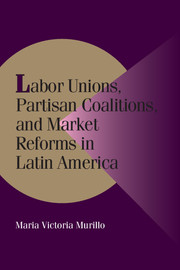Book contents
- Frontmatter
- Contents
- Abstract
- Acknowledgments
- List of Acronyms
- 1 UNIONS' DILEMMA: HOW TO SURVIVE NEOLIBERALISM
- 2 A THEORY OF UNION-GOVERNMENT INTERACTIONS
- 3 THE POPULIST PAST AND ITS INSTITUTIONAL LEGACIES
- 4 A TUG OF WAR: LABOR UNIONS AND MARKET REFORMS IN VENEZUELA
- 5 DIVIDED WE RULE: LABOR UNIONS AND MARKET REFORMS IN MEXICO
- 6 FROM PICKETS TO PRICES: LABOR UNIONS AND MARKET REFORMS IN ARGENTINA
- 7 MULTILEVEL COMPARISON
- 8 LABOR COMPETITION AND PARTISAN COALITIONS
- Bibliography
- Interviews
- Index
- Titles in the series
3 - THE POPULIST PAST AND ITS INSTITUTIONAL LEGACIES
Published online by Cambridge University Press: 05 February 2010
- Frontmatter
- Contents
- Abstract
- Acknowledgments
- List of Acronyms
- 1 UNIONS' DILEMMA: HOW TO SURVIVE NEOLIBERALISM
- 2 A THEORY OF UNION-GOVERNMENT INTERACTIONS
- 3 THE POPULIST PAST AND ITS INSTITUTIONAL LEGACIES
- 4 A TUG OF WAR: LABOR UNIONS AND MARKET REFORMS IN VENEZUELA
- 5 DIVIDED WE RULE: LABOR UNIONS AND MARKET REFORMS IN MEXICO
- 6 FROM PICKETS TO PRICES: LABOR UNIONS AND MARKET REFORMS IN ARGENTINA
- 7 MULTILEVEL COMPARISON
- 8 LABOR COMPETITION AND PARTISAN COALITIONS
- Bibliography
- Interviews
- Index
- Titles in the series
Summary
We are not united by love, but by dread.
Jorge Luis Borges (1964)To you, whose lot it is to sow what others may reap, to labor and obey, and ask no more than the wages of a beast of burden, the food and shelter to keep you alive from day to day. It is to you that I come with my message of salvation, it is to you that I appeal.
Upton Sinclair (1990)On October 17, 1945, three hundred thousand workers marched into downtown Buenos Aires to demand the release of imprisoned Colonel Juan Perón. In the elections of February 1946, the union-organized Labor Party led the political coalition that brought Perón to the presidency. Most workers voted for Perón and taught their children to be Peronist, creating one of the strongest partisan loyalties in Latin America. After all, Perón and the Peronist unions had changed their lives by providing better wages and labor benefits, social security, and even paid vacations in union resorts. Because the labor benefits compensated unions for their previous frustration in dealing with indifferent employers and hostile governments, they identified with Peronism and served as Peronist political machines. In addition to turning unions into key players in the political system, Peronism promoted import substitution industrialization and state-led development, which further reinforced unionization and labor bargaining power.
In 1989, a Peronist candidate, Carlos Menem won the presidential election. During his populist electoral campaign, Menem had promised wage hikes and social justice and threatened not to pay the external debt. However, after his inauguration, he delivered austerity followed by trade liberalization, privatization, and adjustment of the public sector.
- Type
- Chapter
- Information
- Publisher: Cambridge University PressPrint publication year: 2001



